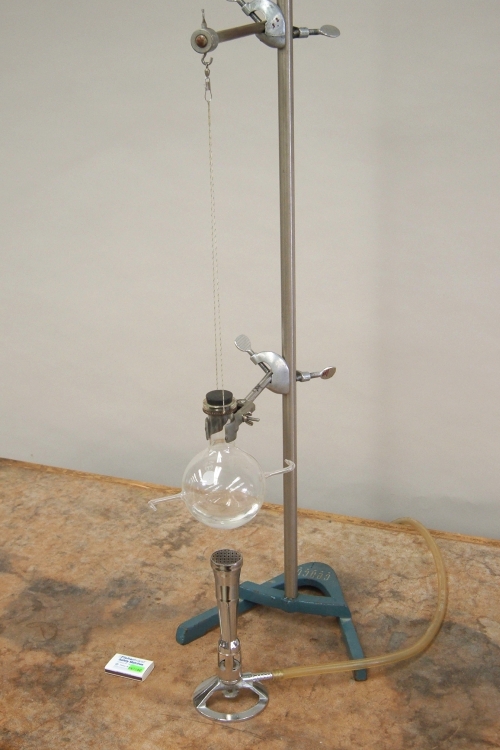
A round-bottom flask that has two nozzles extending from its sides diametrically opposite each other, each with a 90-degree bend at its outer end, contains a small amount of water and is plugged by a rubber stopper in its neck. The flask hangs from a swivel above a Meker burner. When you light the burner, the water begins to boil, and steam builds up inside the flask. As the pressure increases, steam is forced out through the nozzles, producing two jets that exit perpendicular to the diameter of the flask. These jets exert a torque about the central axis of the flask, which causes it to spin. The clamp around the neck, which fits loosely, provides a pivot. It prevents the flask from swinging wildly, and keeps it rotating about a vertical axis.
The apparatus used in this demonstration is similar to one invented by Hero of Alexandria, who lived some time during the first century C.E. You can find information about him on the MacTutor page of The School of Mathematics and Statistics of University of St Andrews, Scotland, and at SciHi Blog, and a photograph of a model of the apparatus at the Smith College Museum of Ancient Inventions. Hero called his device an aeolipile, meaning “wind ball.”
When you light the Meker burner underneath the flask, this raises the temperature of the water inside until it boils. The change in phase of the water from liquid to vapor increases the pressure inside the flask, and it soon exceeds atmospheric pressure. The steam generated by the boiling water is forced out through the nozzles, which it exits as two jets. The exit of each nozzle is perpendicular to the radius along which the nozzle lies. Each jet thus exerts a torque on the flask about its central axis of τ = r × F, where r is the distance of the nozzle exit from the center of the flask, and F, the thrust, equals vdm/dt, where v is the velocity of the steam in the jet relative to the nozzle, and dm/dt is the rate at which the steam exits the nozzle in mass per unit time. This is an example of Newton’s Third Law of Motion, and is the same mechanism by which demonstrations 12.51 -- Water rocket, and 12.54 -- CO2 wagon operate.
This demonstration shows the conversion of heat from the Meker burner, via the changing of liquid water into steam, into the mechanical work of rotating the engine.